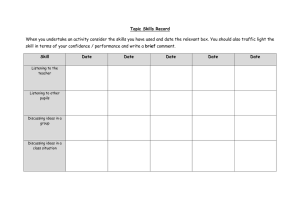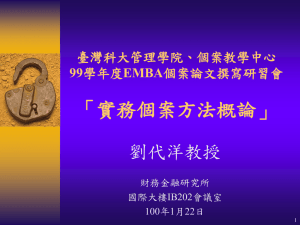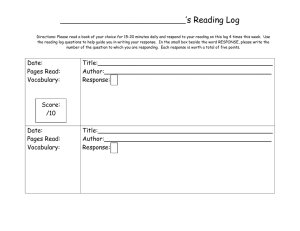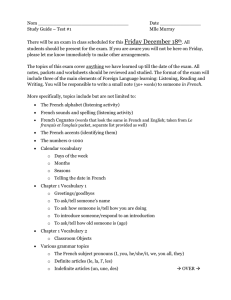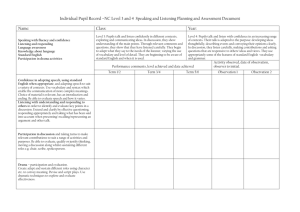Clip #1 - Questioning, listening, and responding (2:28) Garvin 1
advertisement
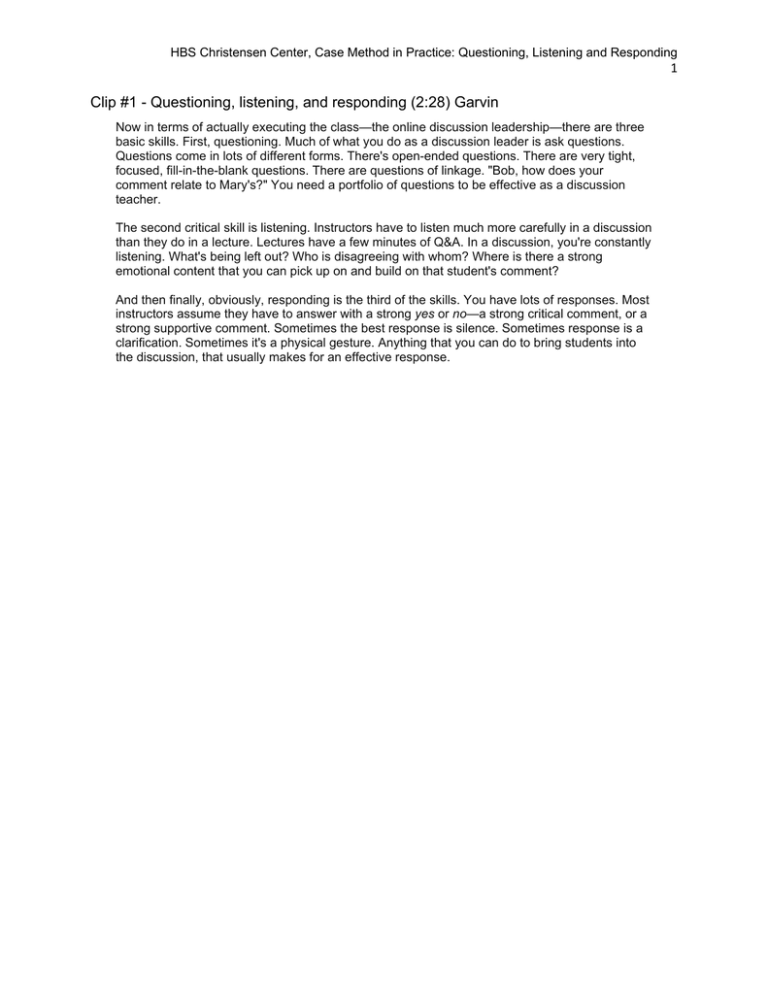
HBS Christensen Center, Case Method in Practice: Questioning, Listening and Responding 1 Clip #1 - Questioning, listening, and responding (2:28) Garvin Now in terms of actually executing the class—the online discussion leadership—there are three basic skills. First, questioning. Much of what you do as a discussion leader is ask questions. Questions come in lots of different forms. There's open-ended questions. There are very tight, focused, fill-in-the-blank questions. There are questions of linkage. "Bob, how does your comment relate to Mary's?" You need a portfolio of questions to be effective as a discussion teacher. The second critical skill is listening. Instructors have to listen much more carefully in a discussion than they do in a lecture. Lectures have a few minutes of Q&A. In a discussion, you're constantly listening. What's being left out? Who is disagreeing with whom? Where is there a strong emotional content that you can pick up on and build on that student's comment? And then finally, obviously, responding is the third of the skills. You have lots of responses. Most instructors assume they have to answer with a strong yes or no—a strong critical comment, or a strong supportive comment. Sometimes the best response is silence. Sometimes response is a clarification. Sometimes it's a physical gesture. Anything that you can do to bring students into the discussion, that usually makes for an effective response. HBS Christensen Center, Case Method in Practice: Questioning, Listening and Responding 2 Clip #2 - Three important characteristics of questions (3:07) Garvin Let me pick up on three important characteristics of questions, which we don't always acknowledge. And they're really tools to make questions even more effective. The first, and this is particularly important for your opening question, is to recognize that a question is both a question—an asking for answers—and a set of instructions. In particular, I will frequently add to my questions, "Let's not discuss X, Y, Z for a while." The reason for that is students often will confound issues. They'll pull together two or three different kinds of issues in their answer. So, at one point during the Donnelley discussion, I said, "Let's look at the first era. But let's hold off on the reengineering of the technology development process. That's actually a separate discussion." By putting that into the question, I narrowed the focus to get a bit more coherence. So that's the first of the really interesting tools that questions offer. The second is to recognize that you have an important choice in when you use an open question and when you use a relatively closed question. An open question is broad. It's very unprescriptive. It really has lots of room for student maneuver. What are the differences between the traditional and digital printing techniques? That's wide open. Lots of answers are possible. On the other hand, the question I use toward the end of class, "Has Barb Schetter's job become broader or narrower as it's evolved over time?"—that has two possible answers and no others. I was driving toward completion there. That's a closed question. So both open and closed questions have their place. Frequently you want to begin with the more open. Use the closed to drive in a particular direction. Now there's a third interesting choice about questions. This one is hard to use because it has some risk to it. You can personalize a question. "Tom, what do you think is the best thing to do here?" "Mary, do you agree with what Tom just said?" In general, when you personalize a question, you heat up the discussion. If you make it more abstract—"What are the underlying themes we've been talking about?"—you tend to reduce the heat. So you have a device here for intensifying the discussion: personalize; and cooling down the discussion: make it more abstract. HBS Christensen Center, Case Method in Practice: Questioning, Listening and Responding 3 Clip #3 - Leading questions (1:23) Nanda PROFESSOR NANDA: I used to ask people what I call leading questions, which is, “I want an answer. Give me the answer. OK, you can give me the answer.” It becomes very transparent after a time that you want the one correct answer that you are looking for. And it really hurts the case discussion method, because then people, instead of speaking their minds, start guessing, what is it that they want me to say? I try to avoid leading questions. If the subject they are discussing is very different from the conceptual piece I am talking about, I put the conceptual piece aside. Yesterday in Family Feud (Andersen vs. Andersen case discussion), there were some conceptual pieces related to negotiation that I just put aside. Otherwise we could have had a three-hour class. I put them aside. We didn't discuss them. But sometimes, if I want to convey something, I just make it very clear to the class I am going a little bit in the lecture mode. So I kind of take a time-out from the case study, and I say, “Listen, here is a concept I want to talk about.” I go into a mini-lecture mode. The class appreciates that. The discussion, the lecture mode, and boom, you're back again to the case study. I think it's better than asking leading questions. HBS Christensen Center, Case Method in Practice: Questioning, Listening and Responding 4 Clip #4 - Listening at four levels (2:01) Garvin As a discussion teacher, I try to listen at four quite different levels. The first one is pretty obvious: I listen for content. I listen for what is said, and how it tracks with the analysis we need to get done. The second thing I listen for is how things are said. There are always emotional undercurrents. Sometimes the voice is tentative. Sometimes the voice is very strong. Sometimes there's a lack of energy in the comments. Sometimes there's tremendous dynamism in the debate. So I'm listening for that particularly so that, when we hit an emotional current, we can ride it. That's where the class tends to take off. The third thing I'm listening for is almost a contradiction in terms. I'm listening for what is left unsaid. Take, for instance, a case which has ethical implications. Students are often very uncomfortable raising the ethical issues. If I go for ten, fifteen, twenty minutes in the heart of a discussion, and people are avoiding that point, I'll raise it. I'm listening for the fact that they haven't said anything about it. And then the fourth thing you listen for, and this one is tricky, is you listen for disconnects. When somebody says X, and somebody comes back with a response that doesn't quite meet them, there is a lack of correspondence somehow. They either didn't get it or they didn't quite take it in and fully understand it. In order to engage the debate they have to be on the same wavelength. So I will go back to either the first person or the second person and say, "Did he get that right?" or, "Are you two talking the same language?" because disconnects can frequently be highly disruptive unless people will meet each other on the same level. HBS Christensen Center, Case Method in Practice: Questioning, Listening and Responding 5 Clip #5 - Teaching students to listen to one another (1:02) Garvin There are two ways you get students to listen to each other. The first is by modeling the behavior yourself. I listen very carefully. I capture the words verbatim. I reflect back by echoing what they've said. Students will begin to do that to each other. The second way I get students to listen to each other is that I correct them if they have misheard. So if John and Bill are having a discussion—John says X, and Bill responds but he doesn't respond to X; he clearly misheard—I will go back to John and say, "Did he get your argument right? Did he capture it?" John says, "No." I say, "Could you repeat it?" And then I go back to Bill. I say, "Now do you want to respond?" I want to reinforce that you have to hear accurately. HBS Christensen Center, Case Method in Practice: Questioning, Listening and Responding 6 Clip #6 - Echoing (1:12) Garvin There is a technique that we often use called echoing, which is a student says something— sometimes convoluted, sometimes hard to understand—but you've picked up the germ of truth in the comment. What you do is you play it back. You echo the comment back to them, but also back to their peers in the class. Now, that's a tricky tactic. Too much echoing and the class becomes very staccato. It's quite disruptive. On the other hand, particularly with students who are not familiar with English: Not enough echoing and you don't get any links among the comments. So you're constantly making a judgment: How much echoing is enough in order to get coherence? HBS Christensen Center, Case Method in Practice: Questioning, Listening and Responding 7 Clip #7 - Responding to Different interpersonal styles (1:19) Nanda PROFESSOR NANDA: Different people take conflict differently. What I have learned over time is to try and change my response to people, depending on the type of people there are. For example, I know that some people are aggressive and their way of learning is point-counterpoint. There will be thesis-antithesis, and then there will be synthesis. So when somebody says something, you will immediately say, “No, Arvinder, if you said this, I totally disagree with what you said.” But what if Hanson says something, and I say, “Hanson, I totally disagree with you,” and then Hanson is totally quiet for the rest of the class? OK? So one has to be sensitive to that a little bit, especially if you are trying to put people in this kind of situation. If at the core you convey to your students or participants that what you are interested in is ideas— you are discussing with them ideas rather than trying to show down individuals—then they go with you. It works fine. You just have to give people—again, sometimes language is an issue—so you want to give people more space to express themselves, but you want to keep going, also. That's why it’s more of an art.

